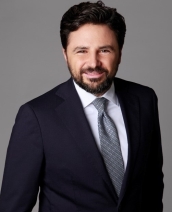Andrea Faggiano
Andrea advises telecom clients on strategic, competition and regulatory topics by leveraging key topics such as network economics, M&A and spectrum management.

Areas of Focus
Education
Past Experience

Andrea is a Partner at Arthur D. Little based in Dubai, leading the TIME Practice in the Middle East and our global competence center, “Strategic Advisory Services for Competition and Regulation” (SASCAR), which is dedicated to telecommunication clients.
As a senior member of our global TIME Practice, Andrea combines expertise in network, infrastructure and regulatory management with strategic investment & market orientation.
Over the 15 years at Arthur D. Little, Andrea has delivered numerous projects in Europe, the Middle East and Latin America for telecom operators (both mobile & fixed) and MVNOs. He is passionate about technology- and regulations-centric topics such as network and technology strategy development, infrastructure economic analysis, wholesale management, M&A support, NGAN & IP interconnection strategies and regulatory & spectrum management.
Additionally, Andrea has delivered many market-oriented projects for telecom operators, focusing on growth strategy, product portfolio design & business planning.
Before joining Arthur D. Little, Andrea worked as a Fixed Network Engineer at Wind Telecommunications.

Telcos: Outsource international voice!

CPAAS: Beyond the hype

Edge computing: Hype or ripe?

Pivoting the international carrier business

Resolving customer complaints in the digital era

The future of enterprise networking

With the Internet of Things (IoT) every- where, can regulation be far behind?

Utilities’ contribution to national fiber development

Telecom retail & consumer protection

The OTT conundrum for MENA telecoms

LTE Spectrum and Network Strategies

Looking Under the Hood of the Internet

Andrea is a Partner at Arthur D. Little based in Dubai, leading the TIME Practice in the Middle East and our global competence center, “Strategic Advisory Services for Competition and Regulation” (SASCAR), which is dedicated to telecommunication clients.
As a senior member of our global TIME Practice, Andrea combines expertise in network, infrastructure and regulatory management with strategic investment & market orientation.
Over the 15 years at Arthur D. Little, Andrea has delivered numerous projects in Europe, the Middle East and Latin America for telecom operators (both mobile & fixed) and MVNOs. He is passionate about technology- and regulations-centric topics such as network and technology strategy development, infrastructure economic analysis, wholesale management, M&A support, NGAN & IP interconnection strategies and regulatory & spectrum management.
Additionally, Andrea has delivered many market-oriented projects for telecom operators, focusing on growth strategy, product portfolio design & business planning.
Before joining Arthur D. Little, Andrea worked as a Fixed Network Engineer at Wind Telecommunications.

Telcos: Outsource international voice!

CPAAS: Beyond the hype

Edge computing: Hype or ripe?

Pivoting the international carrier business

Resolving customer complaints in the digital era

The future of enterprise networking

With the Internet of Things (IoT) every- where, can regulation be far behind?

Utilities’ contribution to national fiber development

Telecom retail & consumer protection

The OTT conundrum for MENA telecoms

LTE Spectrum and Network Strategies

Looking Under the Hood of the Internet
More About Andrea
- University of RomeMaster of Science in Electrical Engineering
- Wind TelecommunicationsNetwork Manager & Investment Planner
